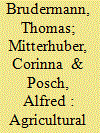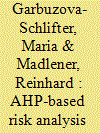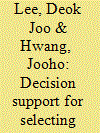|
|
|
Sort Order |
|
|
|
Items / Page
|
|
|
|
|
|
|
| Srl | Item |
| 1 |
ID:
137667


|
|
|
|
|
| Summary/Abstract |
In this paper, we discuss the prospects of agricultural biogas plants. We conducted an integrated SWOT–AHP analysis for such plants in Austria in order to identify strengths, weaknesses, opportunities and threats (SWOT factors), and to weight the factors identified based on expert judgments, calculated according to the Analytic Hierarchy Process (AHP) method. The results show that financial aspects are dominant in three of the four SWOT categories. Technological aspects and issues regarding utilization seem to play a relatively minor role. Factors that are not directly under the control of plant operators are currently perceived as crucial for the success of agricultural biogas plants. We conclude that such plants will only succeed in contributing to sustainable energy supply goals when economic and political conditions are favorable over the long term.
|
|
|
|
|
|
|
|
|
|
|
|
|
|
|
|
| 2 |
ID:
150067


|
|
|
|
|
| Summary/Abstract |
Understanding and properly managing risks that could potentially affect the target- and performance-based profits of energy performance contracting (EPC) projects are essential. It is particularly important for the establishment and success of energy service companies (ESCOs) acting in the vulnerable environment of the vast but highly energy-inefficient Russian market. This study systematically explores common risk factors and causes of risk associated with EPC projects executed in three Russian sectors: (1) industrial; (2) housing and communal services; and (3) public. Several interviews with the Russian EPC experts were accomplished and a qualitative risk assessment by using an analytic hierarchy process (AHP) approach. The data were obtained from a web-based questionnaire survey conducted among Russian EPC project executors. For each focus sector, a specific preference-based ranking of the identified risk factors and causes of risk was derived. The AHP results show that causes of risk related to the financial and regulatory aspects contribute most to the riskiness of EPC projects performed in all three focus sectors in Russia, calling for the special attention of EPC policy- and business-makers. Due to sectorial particularities and different actors involved, we conclude that there is a need for elaboration of sector-specific contractual schemes for EPC projects.
|
|
|
|
|
|
|
|
|
|
|
|
|
|
|
|
| 3 |
ID:
093480


|
|
|
|
|
| Publication |
2010.
|
| Summary/Abstract |
The Korean government plans to increase strategically focused R&D investment in some promising nuclear technology areas to create export opportunities of technology in a global nuclear market. The purpose of this paper is to present a decision support process for selecting promising nuclear technology with the perspective of exportability by using the AHP based on extensive data gathered from nuclear experts in Korea. In this study, the decision criteria for evaluating the export competitiveness of nuclear technologies were determined, and a hierarchical structure for the decision-making process was systematically developed. Subsequently relative weights of decision criteria were derived using AHP methodology and the export competitiveness of nuclear technology alternatives was quantified to prioritize them. We discuss the implications of our results with a viewpoint toward national nuclear technology policy.
|
|
|
|
|
|
|
|
|
|
|
|
|
|
|
|
| 4 |
ID:
115166


|
|
|
|
|
| Publication |
2012.
|
| Summary/Abstract |
This paper evaluates alternative fuels for the Greek road transport sector, using the Analytic Hierarchy Process. Seven different alternatives of fuel mode are considered in this paper: internal combustion engine (ICE) and its combination with petroleum and 1st and 2nd generation biofuels blends, fuel cells, hybrid vehicles, plug-in hybrids and electric vehicles. The evaluation of alternative fuel modes is performed according to cost and policy aspects. In order to evaluate each alternative fuel, one base scenario and ten alternative scenarios with different weight factors selection per criterion are presented. After deciding the alternative fuels' scoring against each criterion and the criteria weights, their synthesis gives the overall score and ranking for all ten alternative scenarios. It is concluded that ICE blended with 1st and 2nd generation biofuels are the most suitable alternative fuels for the Greek road transport sector.
|
|
|
|
|
|
|
|
|
|
|
|
|
|
|
|
| 5 |
ID:
125735


|
|
|
|
|
| Publication |
2013.
|
| Summary/Abstract |
This paper evaluates next generation biomass derived fuels for the transport sector, employing the Analytic Hierarchy Process. Eight different alternatives of fuels are considered in this paper: bio-hydrogen, bio-synthetic natural gas, bio-dimethyl ether, bio-methanol, hydro thermal upgrading diesel, bio-ethanol, algal biofuel and electricity from biomass incineration. The evaluation of alternative fuels is performed according to various criteria that include economic, technical, social and policy aspects. In order to evaluate each alternative fuel, one base scenario and five alternative scenarios with different weight factors selection per criterion are presented. After deciding the alternative fuels' scoring against each criterion and the criteria weights, their synthesis gives the overall score and ranking for all alternative scenarios. It is concluded that synthetic natural gas and electricity from biomass incineration are the most suitable next generation biomass derived fuels for the transport sector.
|
|
|
|
|
|
|
|
|
|
|
|
|
|
|
|
| 6 |
ID:
128449


|
|
|
|
|
| Publication |
2014.
|
| Summary/Abstract |
The use of hydroelectric potential and the protection of the river ecosystem are two contrasting aspects that arise in the management of the same resource, generating conflicts between different stakeholders. The purpose of the paper is to develop a multi-level decision-making tool, able to support energy planning, with specific reference to the construction of hydropower plants in mountain areas. Starting from a real-world problem concerning the basin of the Sesia Valley (Italy), an evaluation framework based on the combined use of Multicriteria Evaluation and Stakeholders Analysis is proposed in the study. The results of the work show that the methodology is able to grant participated decisions through a multi-stakeholders traceable and transparent assessment process, to highlight the important elements of the decision problem and to support the definition of future design guidelines.
|
|
|
|
|
|
|
|
|
|
|
|
|
|
|
|
| 7 |
ID:
166502


|
|
|
|
|
| Summary/Abstract |
To resolve socioeconomic and environmental issues caused by vehicular emissions, the Chinese government has developed a series of policies for promoting clean energy vehicles (CEVs), which can be powered by electricity, gas, ethanol or methanol. Effective implementation of these policies requires a comprehensive evaluation of CEVs. Decision-makers need to take into account multiple criteria such as energy performance, energy cost, vehicular emission, market acceptance and energy security. This paper proposes a decision support model, which applies multi-criteria analysis to prioritize CEVs existing and to be launched on the Chinese market. Government officials, academic researchers and industrial executives are interviewed to select and rank criteria for optimizing decision-making using the Analytic Hierarchy Process and the VIKOR optimization techniques. Thirty-five experts have been interviewed for prioritizing four categories of CEVs including electric, gas, methanol and ethanol vehicles from both the national and provincial perspectives. Results demonstrate that electric vehicles represent the highest ranking, followed by gas, methanol and ethanol vehicles. The proposed model has been validated using statistical data and existing government policies. The proposed multi-criteria analysis can be used for advising decision-makers in the area of clean energy vehicles.
|
|
|
|
|
|
|
|
|
|
|
|
|
|
|
|
|
|
|
|
|